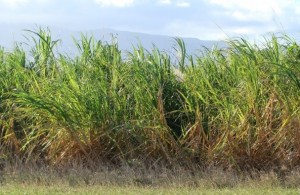HC&S Responds to Herbicide Complaint at Ku’au Sugar Fields
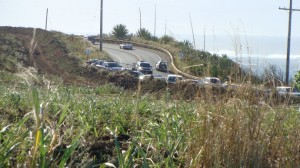
HC&S sugar cane fields line the Hana Highway across from Mama's Fish House in Ku'au. Photo by Wendy Osher.
By Wendy Osher
When taking a drive on the curvy road through Ku’au town, the makai side is splashed with colorful kites of windsurfers below, while the mauka vistas offer a blanket of green, planted in miles of sugar cane.
There’s a small residential community nestled nearby and a scattering of homes close enough to consider Hawaiian Commercial & Sugar Company their neighbor.
This week, Maui Now received a letter from a concerned homeowner who lives in Ku’au near the Mama’s Fish House restaurant. The complaint from resident Chris Wurtele expresses concern over herbicides being sprayed onto adjacent fields with the use of trucks equipped with booms on each side.
The letter was sent on Monday, Jan. 30, and indicated spraying had been conducted over the last few days with no pre-notification.
“We would like the opportunity to close our windows and avoid exposure,” said Wurtele, who cited health concerns, calling the herbicides harmful—a claim officials at HC&S dispute.
There are two fields located in the immediate vicinity: Field 105, located directly across from the Hana Highway from Mama’s Fish House; and Field 107, located to the southeast of Field 105, on the opposite side of a gulch.
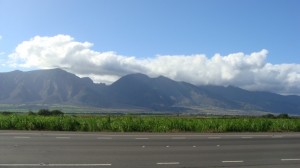
Fields of sugar cane line the Hana Highway, offer unobscured views of the West Maui Mountains. Photo by Wendy Osher.
Why Weed Control?
Both fields were recently planted and are now covered in young cane—a stage in which herbicides are used to help control weed growth.
HC&S General Manager Rick Volner Jr. said weed control is necessary during the first six months of growth to prevent weeds from competing with the young crop for sunlight, water and nutrients.
Company officials say, once the crop is established, weeds are generally controlled by the cane naturally shading out the weeds below.
After that, “further herbicide applications are not required, except in unusual circumstances,” said Volner, who noted additional applications could be used to control vines growing over the crop canopy.
HC&S confirms that applications of herbicide were conducted on both fields during the period in question: Herbicides were used on Field 105 on January 27-30, and a tractor application of herbicide was conducted at Field 107 on January 28.
What Herbicides are being used?
When Wurtele called HC&S to find out what was being used, he said he was told that it was atrazine, applied in a mixture with two other herbicides.
Volner confirms a herbicide mix was applied to both fields by tractor, containing Aatrex Nine-O (atrazine), Clean Amine (2,4-D), Prowl (pendimethalin), Rifle (dicamba), and Velpar (hexazinone).
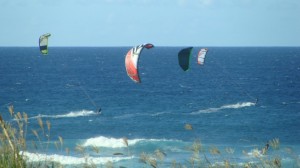
Makai view from sugar cane fields: Just off-shore from the coastal highway at Ku'au, windsurfers catch a wave. Photo by Wendy Osher.
Banned or approved?
Wurtel argues that atrazine was banned by the EU in 2004 because of its toxicity and ability to contaminate groundwater, a claim also referenced on Wikipedia.
Based on interpretation, the claim has been argued both ways.
It is countered by both HC&S and its parent company A&B.
A&B’s Director of Environmental Affairs Sean O’Keefe disputes the resident’s comments specific to atrazine, saying it is incorrect.
O’Keefe said atrazine is not banned by the EU (European Union). He said the European Commission excluded atrazine from a re-registration process in 2003 because the registrants did not supply sufficient water monitoring data.
“Atrazine has not been assessed and de-registered because of any human health or environmental concern, is not on any EU ‘banned list’ and could theoretically be re-registered in the EU should the product registrant provide all the required data,” said O’Keefe.
Volner adds that each of the herbicide’s active ingredients applied to these fields has completed pesticide re-registration with the EPA, which evaluates the pesticide to ensure that it will not have unreasonable adverse effects on humans, the environment and non-target species when used in accordance with the approved pesticide label.
What about health effects?
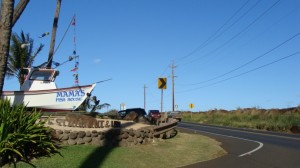
The field across from Mama's Fish House in Ku'au is currently planted with young sugar cane. Photo by Wendy Osher.
Resident complaints further state that atrazine has been proven to cause birth defects, low birth weights, and menstrual problems at concentrations below federal safety standards.
A Wikipedia search of Atrazine returns information that is consistent with Wurtele’s claims.
O’Keefe disputes this claim, referencing EPA source materials and drinking water system monitoring data.
Presuming the effects are in reference to the EPA’s maximum contaminant level (MCL) for atrazine in drinking water, O’Keefe said, “There are no drinking water sources on Maui that have been impacted by atrazine, and no drinking water wells in the state that have been impacted by atrazine at levels remotely approaching the MCL.”
“That aside, the MCL for atrazine has been set by EPA at the same level as the maximum contaminant level goal (MCLG), the maximum level in drinking water at which no known or anticipated adverse effect on the health of persons would occur, and which allows an adequate margin of safety.”
O’Keefe further states, “The exposure that the EPA allows is at least 300 to 1000 times more protective than the level where the EPA saw no adverse effects in the most sensitive animal species tested.”
What next?
Wurtele asked that increased public awareness be shared and that information be sought on claims surrounding herbicide use.
“Only through public pressure will we be successful in banning this toxic herbicide,” said Wurtele.
HC&S maintains that the herbicides as used are safe and continue to dispute the claims referenced.



